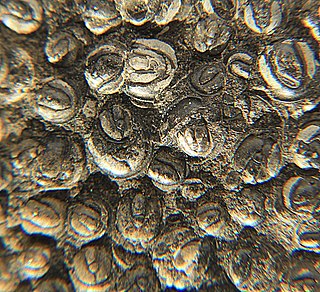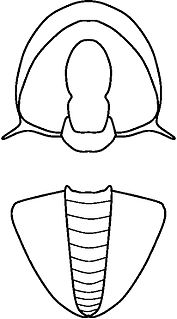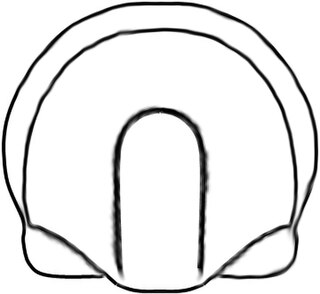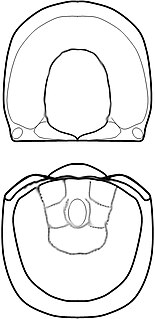
Agnostus is a genus of agnostid trilobites that lived during the upper Middle Cambrian–lower Upper Cambrian. It is the type genus of the family Agnostidae. It is subdivided into two subgenera, Agnostus and Homagnostus.

Acidiscus is an extinct genus of eodiscinid agnostid trilobites. It lived during the Botomian stage of the Cambrian period.

Acimetopus is a genus of trilobites that lived during the Botomian stage.
Acadagnostus is a genus of trilobite from the Middle Cambrian, with 7 species currently recognized. The type species A. acadicus has the widest distribution known from any peronopsid and has been found in North America, Greenland, England, Western Europe, Eastern Europe, Central Asia, the Altai Mountains, the Siberian shield, China, and Australia.
Lotagnostus is a genus of very small trilobites in the order Agnostida, which lived on the outer continental shelves worldwide, during the late Upper Cambrian. It was described by Whitehouse in 1936, and the type species is Lotagnostus trisectus, which was originally described as a species of Agnostus by Salter in 1864.

Phalagnostus is a genus of small trilobites, in the order Agnostida. It lived during the Middle Cambrian, in what are now Canada, China, the Czech Republic, Denmark, England, France, the Russian Federation, Wales, Sweden, and possibly the United States (Vermont). The headshield is almost entirely effaced and wider than the tailshield. The pygidium is also very effaced, but the ovate pygidial axis is well defined and a border furrow is also present.

Pseudonaraoia is a genus of small marine arthropods within the family Naraoiidae, that lived during the late Middle Ordovician period. The only species presently known is Pseudonaraoia hammanni.

Weymouthia is an extinct genus of eodiscinid agnostid trilobites, which lived at the end of the Lower Cambrian, in what are now the eastern United States, England, Siberia and China.

Trinodus is a very small to small blind trilobite, a well known group of extinct marine arthropods, which lived during the Ordovician, in what are now the Yukon Territories, Virginia, Italy, Czech Republic, Poland, Denmark, Sweden, Svalbard, Ireland, Scotland, Wales, Iran, Kazakhstan and China. It is one of the last of the Agnostida order to survive.

Marocconus is an extinct genus from a well-known class of fossil marine arthropods, the trilobites. It is still debated if it lived at the very end of the Lower Cambrian or at the very beginning of the Middle Cambrian. Marocconus notabilis is the only known species in this genus.

Mallagnostus is an extinct genus from a well-known class of fossil marine arthropods, the trilobites. It lived during the upper Lower Cambrian, with remains found in USA, Canada (Newfoundland), Spain, England, Russia, Mongolia, and the lower Middle Cambrian according to fossils from China and Russia (Yakutia).

Galbagnostus is an extinct genus of agnostid trilobite. It lived during the Lower and Middle Ordovician.

Thoracocare is a minute to very small trilobite, that lived during part of the Middle Cambrian in what are today the states of Idaho, Nevada and Utah. It is the only trilobite known with just two thorax segments outside most members of the Agnostida order. It can be distinguished from Agnostida by the very wide subquadrate glabella, parallel-side or widening forward in the largest specimen, with the full front side touching the border. Two species are known, one, T. idahoensis, only from pygidia.
Diplorrhina is a genus of trilobites, a well known class of extinct marine arthropods. It lived during the early Middle Cambrian in what are now the Czech Republic and the North Siberian plateau. Like all agnostina it has a headshield (or cephalon and tailshield (or pygidium of approximately the same shape and size, and two thorax segments. Like other members of the Peronopsidae family, it lacks a furrow connecting the furrow surrounding the central raise area of the cephalon and the furrow that defines the border of the cephalon. Both the cephalon and the pygidium lack spines. It is difficult to distinguish from many other peronopsids.

Geragnostus is a genus of very small agnostid trilobites whose fossils are found Ordovician-aged marine strata from Eurasia, North America and Argentina.

Toragnostus is a genus of trilobites restricted to the late Middle Cambrian. Its remains have been found in the United States, Greenland, Denmark, China, Sweden, the Russian Federation, and Kazakhstan. Its headshield and tailshield are almost completely effaced and it has two thorax segments.

Cyclopyge is a genus of small to average size trilobites that lived during the Ordovician. Like all members of the family Cyclopigidae, it has very large convex eyes, that cover most of the free cheeks, and in some species touch each other. The eyes almost touch the large glabella. The occipital ring has merged with the rest of the glabella. The glabella does not extend into a frontal thorn. The cephalon lacks genal spines. The 6 thorax segments have short pleurae. The pygidium is rather large, and often rather effaced. These are features that also occur in other Cyclopygidae, and are indications of a pelagic lifestyle.

Eodiscidae is a family of agnostid trilobites that lived during the final Lower Cambrian and the Middle Cambrian. They are small or very small, and have a thorax of two or three segments. Eodiscidae includes nine genera.
Plutonides is a genus of trilobite, an extinct group of marine arthropods. Species occur in the middle Middle Cambrian of Russia (Siberia), Mongolia, England and Wales, Sweden, eastern Canada, and the Czech Republic. The frontal lobe of the central raised area of the headshield overhangs the short frontal border and it is slightly pointed, rather than rounded or truncate. This character is shared with Anabaraspis, but in Anabaraspis there is a wide area in front of the glabella without a differentiated border and preglabellar field.

Serrodiscus is an extinct genus from a well-known class of fossil marine arthropods, the trilobites. It has been collected from the Lower Cambrian of Canada, Germany (Silesia), Poland, Russia, the United Kingdom (Wales) and the United States. It is named for the spines on the ventral side of the tailshield (or pygidium, which give it a serrated impression.



















